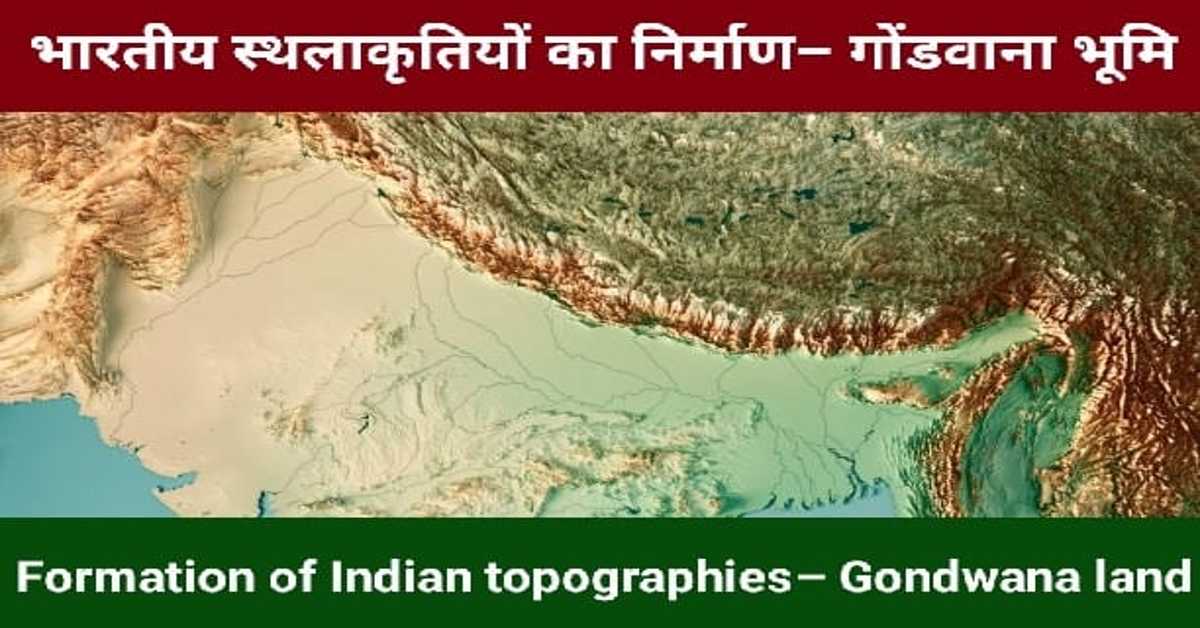
भारतीय स्थलाकृतियों का निर्माण– गोंडवाना भूमि | Formation of Indian topographies– Gondwana land
गोंडवाना भूमि (Gondwana land)
गोंडवाना भूमि प्राचीन विशाल महाद्वीप पैंजिया का दक्षिणतम भाग है। इसके उत्तर में अंगारा भूमि है। भारत का सबसे प्राचीन प्रायद्वीपीय भाग (भू-भाग) गोंडवाना भूमि का ही एक भाग है। गोंडवाना भूमि के विशाल क्षेत्र में भारत, ऑस्ट्रेलिया, दक्षिण अफ्रीका, दक्षिण अमेरिका और अंटार्कटिका के क्षेत्र सम्मिलित हैं। प्राचीन काल में संवहनीय धाराओं के कारण गोंडवाना भूमि की पर्पटी अनेक टुकड़ों में बँट गई। परिणामस्वरूप गोंडवाना भूमि की कुछ छोटी प्लेटें अलग-अलग दिशाओं में प्रवाहित होने लगीं। इसके अंतर्गत भारत और ऑस्ट्रेलिया की प्लेट गोंडवाना भूमि से अलग होने के पश्चात् उत्तर दिशा की ओर प्रवाहित होने लगीं। इस कारण भारतीय प्लेट, यूरेशियन प्लेट से टकरायी। यूरेशियन प्लेट भारतीय प्लेट से बहुत विशाल थी। भारतीय प्लेट और यूरेशियन प्लेट के टकराव की वजह से इन दोनों प्लेटों के मध्य स्थित 'टेथिस' भू-अवनति के अवसादी चट्टान वलित होने लगे। परिणामस्वरूप हिमालय और पश्चिम एशिया की पर्वत श्रंखलाओं का विकास हुआ।
The land of Gondwana is the southernmost part of the ancient giant continent Pangea. To its north is the land of Angara. The oldest peninsular part of India (the landmass) is a part of the Gondwana land itself. The vast area of Gondwana land includes areas of India, Australia, South Africa, South America and Antarctica. In ancient times, due to convective currents, the crust of the Gondwana land was divided into many pieces. As a result some small plates of Gondwana land started flowing in different directions. Under this, the plates of India and Australia started flowing towards the north after separating from the Gondwana land. Due to this the Indian plate collided with the Eurasian plate. The Eurasian plate was much larger than the Indian plate. Due to the collision of the Indian Plate and the Eurasian Plate, the sedimentary rocks of the 'Tethys' geodesic located between these two plates began to fold. As a result, the Himalayas and mountain ranges of West Asia developed.
भूगोल के इन 👇 प्रकरणों को भी पढ़ें। (Also read these 👇 episodes of Geography.)
भारत एवं विश्व के देशों के आकार व स्थिति | Size And Position Of India And Countries Of The World
भारतीय स्थलाकृतियों का निर्माण (Formation of Indian topographies)
'टेथिस' भू-अवनति के हिमालय पर्वत के रूप में उभर जाने के कारण प्रायद्वीपीय पठार के उत्तरी किनारे नीचे धँस गए। फलस्वरूप एक बहुत बड़ी द्रोणी का निर्माण हुआ। हिमालय पर्वत के निर्माण के बाद इससे विभिन्न नदियों का उद्गम हुआ। आगे चलकर प्रायद्वीपीय भारत के बेसिन उत्तर के पर्वतों और दक्षिण के प्रायद्वीपीय पठारों से बहने वाली नदियों के अवसादी निक्षेपों द्वारा धीरे-धीरे भर गया। इस प्रकार जलोढ़ निक्षपों के द्वारा एक विशाल समतल भूभाग का निर्माण हुआ। इसे भारत के उत्तरी मैदान के नाम से जाना जाता है।
'Tethys' Due to the rise of the Himalaya Mountains, the northern edge of the peninsular plateau submerged down. As a result a huge basin was formed. After the formation of the Himalaya Mountains, various rivers originated from it. Later on, the basin of peninsular India was gradually filled by sedimentary deposits of rivers flowing from the mountains to the north and the peninsular plateaus of the south. In this way a huge flat terrain was formed by alluvial deposits. It is known as the Northern Plain of India.
भूगोल के इन 👇 प्रकरणों को भी पढ़ें। (Also read these 👇 episodes of Geography.)
विश्व तथा भारत (एवं उसके पड़ोसी देश) | World And India (And Its Neighboring Countries)
भारतवर्ष की भूमि बहुत अधिक भौतिक विभिन्नताओं को प्रदर्शित करती है। भू-गर्भीय आधार पर भारत का प्रायद्वीपीय पठार पृथ्वी की सतह का प्राचीनतम हिस्सा है। यह भूमि का एक बहुत ही स्थिर भाग है, किंतु हाल ही के भूकंप ने इस बात को गलत साबित कर दिया है। हिमालय और उत्तरी मैदान हाल ही में निर्मित स्थलाकृतियाँ हैं। हिमालय पर्वत भू-पर्पटी का एक अस्थिर भाग है। हिमालय की सभी पर्वत श्रंखलाएँ एक युवा स्थलाकृति को प्रदर्शित करती हैं। इसके अंतर्गत ऊँचे शिखर, गहरी घाटियाँ और तेज बहने वाली नदियाँ शामिल हैं। उत्तरी मैदान का निर्माण जालोढ़ निक्षेपों से हुआ है। प्रायद्वीपीय पठार आग्नेय और रूपांतरित शैलों वाली कम ऊँची पहाड़ियों और चौड़ी घाटियों से निर्मित हुआ है।
The land of Bharatvarsha exhibits a lot of physical variations. On a geological basis, the Peninsular Plateau of India is the oldest part of the Earth's surface. It is a very stable piece of land, but the recent earthquake has proved this point wrong. The Himalayas and the Northern Plains are recently formed topographies. The Himalaya Mountains are an unstable part of the earth's crust. All the mountain ranges of the Himalayas display a youthful topography. It includes high peaks, deep valleys and fast flowing rivers. The northern plain is formed by alluvial deposits. The Peninsular Plateau is made up of low hills and broad valleys with igneous and metamorphic rocks.
भूगोल के इन 👇 प्रकरणों को भी पढ़ें। (Also read these 👇 episodes of Geography.)
भारत की स्थलाकृतियाँ– शैलें और प्लेटें | Topography Of India– Rocks And Plates
भारत की स्थलाकृतियों का भौगोलिक वितरण (Geographical distribution of topographies of India)
भारत की भौगोलिक आकृतियों को निम्नलिखित वर्गों में बाँटा जा सकता है–
1. हिमालय पर्वत श्रंखला
2. उत्तरी मैदान
3. प्रायद्वीपीय पठार
4. भारतीय मरुस्थल
5. तटीय मैदान
6. द्वीपसमूह
Geographical figures of India can be divided into the following categories-
1. Himalayan mountain range
2. Northern Plain
3. Peninsular Plateau
4. Indian Desert
5. Coastal Plain
6. Archipelago
रसायन विज्ञान के इन 👇 प्रकरणों को भी पढ़ें। (Also read these 👇 episodes of Chemistry.)
क्रिस्टलन का जल– जिप्सम और प्लास्टर ऑफ पेरिस | Water Of Crystallisation– Gypsum And Plaster Of Paris
आशा है, उपरोक्त जानकारी आपके लिए उपयोगी होगी।
धन्यवाद।
R F Temre
rfcompetition.com
आशा है, उपरोक्त जानकारी उपयोगी एवं महत्वपूर्ण होगी।
(I hope the above information will be useful and important. )
Thank you.
R. F. Tembhre
(Teacher)
pragyaab.com




Comments